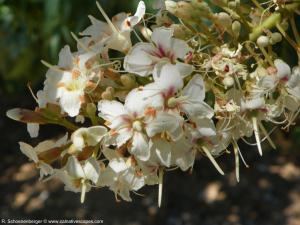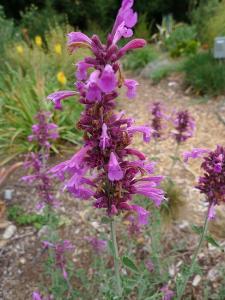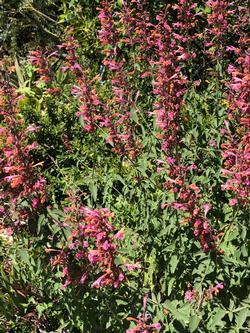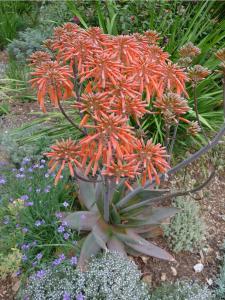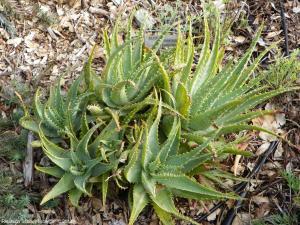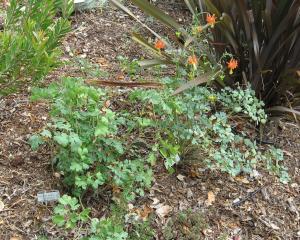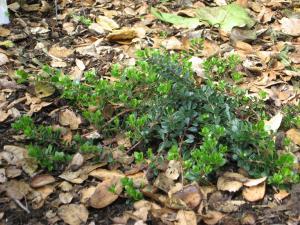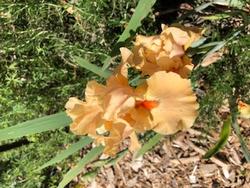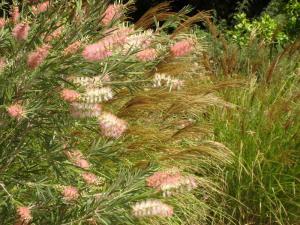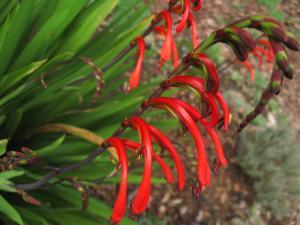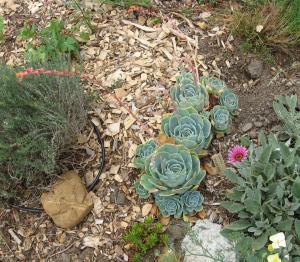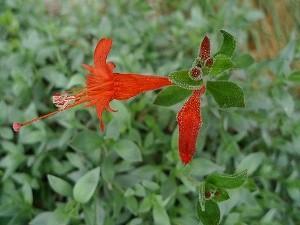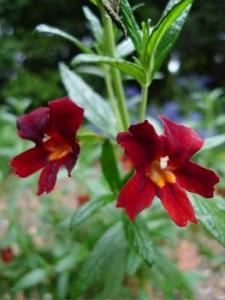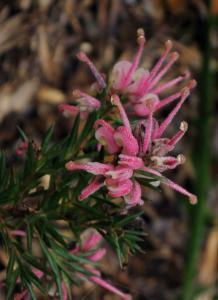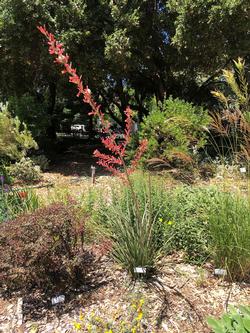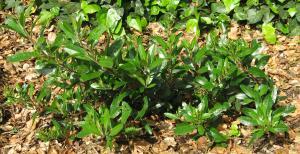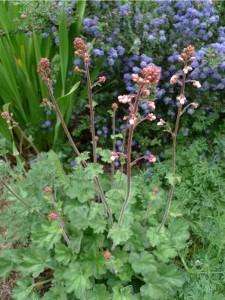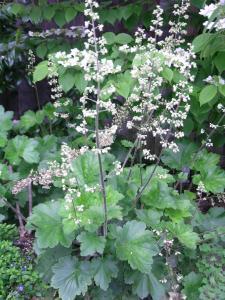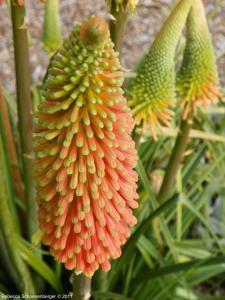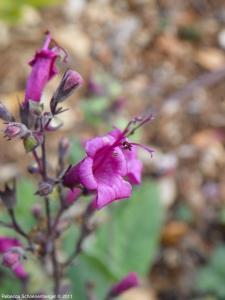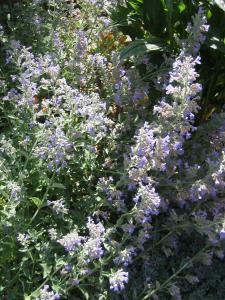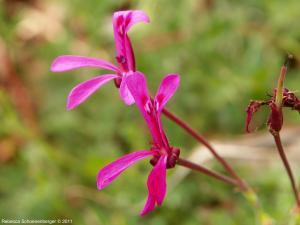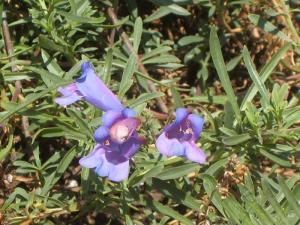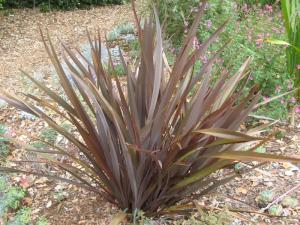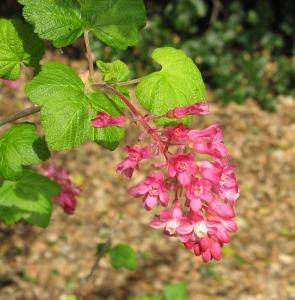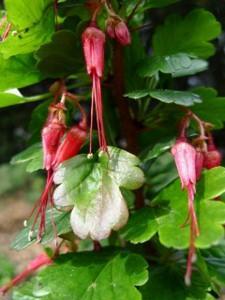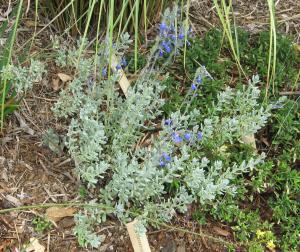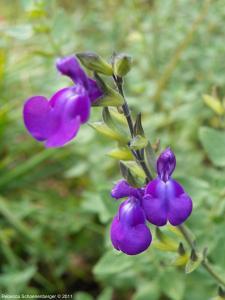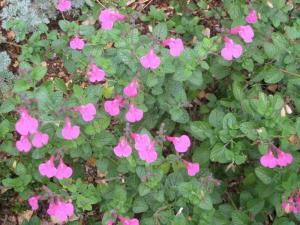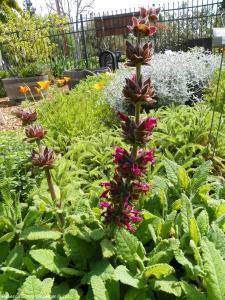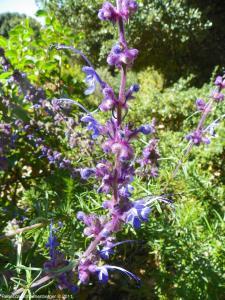Water Wise Plants
Here's a full list of all our water wise plants. You can also view an image gallery, or view the plants by categories.
Aesculus californica
Pronunciation
ES-kew-lus ka-li-FOR-ni-ka
Common Name
California Buckeye
Plant Type
Tree
Mature Size
Can grow 10 - 25 ft. or more, and spread 30 ft. or wider
Water Requirements
Very Low: water deeply several times a summer
Sun/Shade Requirements
Full to half sun, shade
Wildlife
Flower Color
White to pink
Where to See
Maintenance- Design- Planting Tips
The California buckeye is an unusual native because it is summer deciduous. It will naturally drop its leaves with the heat of summer, but with regular watering it may hold leaves longer. Its nectar/pollen is poisonous to European honeybees, but not to native bees. The flower has a candy or perfume-like scent, and blooms in very early spring.
The tree produces a large nut that resembles a buck's eye, thus the name. The nut is poisonous to eat. The nuts easily reseed where they fall, so collect them if new sprouts are not desired. Without summer leaves, the pale bark of the California buckeye offers interest and structure in the garden and is very easy to prune and shape. |
Agastache
Pronunciation
ag-ah-STAK-ee
Common Name
Agastache
Plant Type
Perennial
Mature Size
3 ft. wide and 2 ft. tall
Water Requirements
Low: water every three weeks until the root ball is wet
Sun/Shade Requirements
Full sun
Wildlife
Flower Color
Pink
Where to See
Maintenance- Design- Planting Tips
Agastache are originally from the Southwest and Mexico, a climate that is somewhat different from Santa Clara County’s Mediterranean summer-dry climate. These plants require well-draining soil, but local soils tend to be slow-draining clay soils.
PADG notes: This unnamed cultivar of Agastache has been a mixed success in our gardens. |
Agastache ‘Acapulco Salmon and Pink’
Pronunciation
ah-ga-STAHK-ee
Common Name
Hummingbird mint
Plant Type
Perennial
Mature Size
2'-2.5' high x 1.5' wide
Water Requirements
Moderate: water weekly until the root ball is wet
Sun/Shade Requirements
Full to half sun
Wildlife
Flower Color
Orange and Pink
Where to See
Maintenance- Design- Planting Tips
Agastache ‘Acapulco Salmon and Pink’ is a beautiful accent plant for the late spring to early fall garden. It is more compact than most hummingbird mints and is densely covered by orange and pink flower spikes. The plant’s gray-green foliage is also a nice contrast to the brighter greens of most garden plants. Like many perennials, these plants die back during the winter. Hummingbird mints are only moderately drought tolerant. This plant does not flower well unless it is in full sun for half a day or more.
PADG notes: This specimen is planted where it gets morning sun and afternoon shade so it needs less water than recommended. During hot, summer periods, the plant is hosed weekly in addition to a once every three-week drip irrigation cycle. |
Aloe striata
Pronunciation
AL-oh stree-AH-tuh
Common Name
Coral Aloe
Plant Type
Succulent
Mature Size
2 ft. to 3 ft. tall and 1 ft. to 2 ft. wide
Water Requirements
Low: water every three weeks until the root ball is wet
Sun/Shade Requirements
Full sun
Wildlife
Flower Color
Red-orange
Where to See
Maintenance- Design- Planting Tips
Like many succulents, Aloes are from South Africa. Aloe striata tolerates cold better than most aloes and grows successfully in the Bay Area. The large, broad, fleshy leaves and tall clusters of flowers are bold additions to the summer-dry perennial bed. As a bonus, hummingbirds and bees are attracted to its orange-red blossoms.
The only maintenance this plant needs is to cut back the inflorescence after the flowers have dropped off. Aloe striata is also easy to propagate. Remove the pups (baby plants) from the base of the plant, let the stems dry and harden, and then plant the cuttings in a pot of cactus soil mix. |
Aloe x spinosissima
Pronunciation
AL-oh spin-oh-Siss-e-ma
Common Name
Spider Aloe
Plant Type
Succulent
Mature Size
2-3 ft. high, 2-4 ft. wide
Water Requirements
Very Low: water deeply several times a summer
Sun/Shade Requirements
Full to half sun, shade
Wildlife
Flower Color
Red-orange
Where to See
Maintenance- Design- Planting Tips
Spider aloe is a slow-growing succulent, making it unlikely to outgrow its space or crowd its neighbors. This low-maintenance plant is an excellent specimen for a small low-water garden.
It’s a striking plant with an interesting form – it almost looks like a piece of modern sculpture. Spider aloe is frost-tender so be sure to protect it on cold winter nights. PADG notes: In the winter, spider aloe is rumored to have red flower spikes that are attractive to hummingbirds. Unfortunately, this cannot be confirmed because the plant has never bloomed in our location. |
Aquilegia eximia
Pronunciation
ak-will-EE-jah Eks-IM-mee-uh
Common Name
Serpentine Columbine
Plant Type
Perennial
Mature Size
5 ft. high and 1.5 ft. wide
Water Requirements
Low: water every three weeks until the root ball is wet
Sun/Shade Requirements
Half sun
Wildlife
Flower Color
Yellow and orange
Where to See
Maintenance- Design- Planting Tips
Columbines are great plants for woodland areas. Their blooms are delicate and lovely. In the summer, the foliage tends to die back. Aquilegia eximia, a California native, is a UC Davis Arboretum All-Star plant.
PADG notes: Our Aquilegia eximia planted in partial sun hasn't done as well as we would like. We are trying it in a shady spot. The plant may need more water than our water wise garden is given. |
Arctostaphylos ‘Emerald Carpet’
Pronunciation
ark-toe-STAF-il-lohs
Common Name
Manzanita ‘Emerald Carpet’
Plant Type
Groundcover
Mature Size
5 ft. wide and 8-14 in. tall
Water Requirements
Low: water every three weeks until the root ball is wet
Sun/Shade Requirements
Full to half sun
Wildlife
Flower Color
Pink flowers
Where to See
Maintenance- Design- Planting Tips
‘Emerald Carpet’ is a slow growing California native manzanita from the coast of Mendocino County. It is a very attractive plant with dark glossy leaves, reddish stems and small flowers in the early spring. There are many different cultivars of manzanita, ranging from ground covers to small trees. Manzanitas are a good wildlife plant and typically are a hearty plant. They do well in very dry situations. Most manzanitas need superb drainage, or they will struggle and die. Plant on a mound or slope and water weekly for the first summer and less after that. By the third summer, stop watering. Avoid fertilizing the plant. These plants rarely need pruning. Remove the odd branch that dies back in the late summer and the plant will fill in. Some gardeners will remove the lower branches on some of the larger manzanitas to highlight the interesting branching structure and reddish bark. Some Santa Clara Master Gardeners have had success using the cultivar ‘Carmel Sur’ as a ground cover in low-water landscapes. PADG notes: ‘Emerald Carpet’ has not thrived at PADG. It may need more water than most manzanitas. |
Bearded Iris
Pronunciation
Common Name
Bearded Iris
Plant Type
Bulb
Mature Size
1.5 to 4 feet high Spreads via rhizomes
Water Requirements
Low: water every three weeks until the root ball is wet
Sun/Shade Requirements
Full to half sun
Wildlife
Flower Color
Many colors except true red and green,
Where to See
Maintenance- Design- Planting Tips
Bearded irises are beloved for their showy spring flowers, structurally pleasing upright, green leaves and low, summer water needs. They come in a wide range of colors and shapes. Choosing a mix of early, mid and late bloomers prolongs the spring bloom period, and the addition of re-blooming varieties gives another flush of flowers in the fall and winter season. Unfortunately, re-blooming varieties do need water year-round to re-bloom, and the second bloom has fewer flowers. All bearded irises need full sun for at least half the day to bloom well.
Given enough water from late fall through spring, intermediate bearded iris can grow to a height of 2.5 feet tall, and tall bearded iris can reach 4 feet in height. With enough water they develop tall flower stalks supporting numerous large blooms. With less water during the growing season, the plants are smaller with fewer flowers, but the blooms are still striking. Improve growth by adding compost and mulch in the fall, which helps retain soil moisture and provides nutrients for better bloom. Allow plant leaves and soil to dry out between watering to prevent fungal infections and flower loss. During the summer, bearded irises are dormant, and their leaves die back. For aesthetics many people cut the leaves back when they begin to yellow, but it is not necessary. Plants remain healthy with and without summer trims. Be aware though, there is one major maintenance issue when growing bearded iris. These plants grow from thick rhizomes. Each year new rhizomes spread from the original making a larger clump. As the older rhizomes die, a dead spot will eventually appear in the center of the iris clump. To prevent this from happening and to keep clump size in check, divide iris rhizomes about every three years. Do this during the hot summer months when plants are dormant and fungal infections are less likely to affect the cuts from the mother rhizomes. |
Callistemon ‘Canes Hybrid’
Pronunciation
kal-is-TEM-on
Common Name
Bottlebrush
Plant Type
Shrub
Mature Size
8 ft. to 10 ft. wide and tall
Water Requirements
Low: water every three weeks until the root ball is wet
Sun/Shade Requirements
Full to half sun
Wildlife
Flower Color
Soft pink
Where to See
Maintenance- Design- Planting Tips
Callistemon ‘Canes Hybrid’ is a beautiful shrub that adds height and structure to the perennial garden, with soft pink flowers that bloom repeatedly throughout the summer. The cultivar ‘Canes Hybrid’ is smaller and has softer, greyer foliage than the more common red Callistemon citrinus.
Callistemon are very adaptable plants for Santa Clara Valley gardens and are attractive to hummingbirds. The many cultivars of Callistemon range from tree-size to shrub-size to ground cover height. PADG notes: The Callistemon is pruned and shaped to a shrub and is has been planted next to Miscanthus sinensis ‘Yaku Jima’ as seen in the photo. |
Chasmanthe
Pronunciation
chas-MAN-thee
Common Name
Chasmanthe or cobra lily
Plant Type
Bulb
Mature Size
3 ft. to 3 1/2 ft. tall
Water Requirements
Low: water every three weeks until the root ball is wet
Sun/Shade Requirements
Full to half sun
Wildlife
Flower Color
Orange-red
Where to See
Maintenance- Design- Planting Tips
Chasmanthe is one of the South African perennials that does very well in the Santa Clara County climate. Foliage appears in the fall, orange-red flowers appear in the winter, and the plant goes dormant in the summer. Chasmanthe needs no summer water. There is also a yellow flowered version, called Chasmanthe floribunda duckittii.
For best flowering, corms should be divided every two to three years. Be aware that the plant will reseed vigorously, particularly Chasmanthe aethiopica, so be sure to deadhead the flowers if this is not desired. |
Echeveria sp.
Pronunciation
ech-eh-ver-EE-a
Common Name
Plant Type
Succulent
Mature Size
Less that 1 ft. tall and wide
Water Requirements
Low: water every three weeks until the root ball is wet
Sun/Shade Requirements
Half sun to shade
Wildlife
Flower Color
Pink, red with yellow tips
Where to See
Maintenance- Design- Planting Tips
Echeveria is a good filler or edging plant for the summer-dry flower border and also does well in pots. The sculptural quality of the fleshy leaves provides a nice contrast to the more delicate leaves of many perennials.
Echeverias are sometimes called ‘Hen and Chicks’, but so are Sempervivums, another succulent. It's one of the problems with using common names. In this case, it is better to use the botanical name, Echeveria. PADG Notes: Echeveria ‘Imbricata’, a UC Davis Arboretum All-Star, is featured in the Demonstration Garden. Some Echeverias do well in full sun, but Imbricata seems to do better in half shade and with a drip very close to the roots. |
Epilobium ‘Select Mattole’
Pronunciation
Ep-ih-LOW-bee-um
Common Name
Hummingbird Fuchsia ‘Select Mattole’
Plant Type
Shrub
Mature Size
1 ft tall and 2 ft. wide
Water Requirements
Very Low: water deeply several times a summer
Sun/Shade Requirements
Full to half sun
Wildlife
Flower Color
Red orange
Where to See
Maintenance- Design- Planting Tips
California native fuchsias are a welcome addition to the waterwise garden. They produce masses of red-orange flowers all summer long, at a time when many other native plants are dormant. Hummingbirds love these tubular flowers. ‘Select Mattole’ is one of many cultivars available. Its silver-green foliage foliage shines in the garden. It stays compact and doesn't spread.
Cut California fuchsias back to one inch stubs in the fall or winter. For varieties that tend to ranginess, pinching the outer tips in late May or June will encourage them to be denser and less floppy. California fuchsias are drought tolerant and can be completely summer dry, but will be lusher if given a once a month deep watering. |
Erythranthe guttata
Pronunciation
er-EE-thranthe goo-TA-ta
Common Name
Monkey Flower
Plant Type
Perennial
Mature Size
2 1/2 ft. tall and wide
Water Requirements
Low: water every three weeks until the root ball is wet
Sun/Shade Requirements
Full to half sun, shade
Wildlife
Flower Color
White, cream, yellow, orange, copper, salmon, red, maroon
Where to See
Maintenance- Design- Planting Tips
Mimulus is a cheerful California native that adds bright color to the garden. This shrubby perennial has been hybridized heavily to produce a rainbow of colors. In the wild, different species of Mimulus can be found from southern Oregon to southern California.
Happy in sun or part shade, these plants prefer good drainage. With supplemental water, you can expect some repeat bloom all summer. Mimulus is a favorite in native plant gardens because of its color range. When new foliage appears at its base in late winter, the plant is ready to be pruned back to the new green growth. This hard pruning will rejuvenate the plant. If there is no growth at the base, then gently pinch the tips to encourage new growth. The scientific name of this plant was recently changed from Mimulus guttatus to Erythranthe guttata. PADG notes: Some Master Gardeners have found this plant to be short-lived; other Master Gardeners have Mimulus plants in their personal gardens that are over five years old and doing just fine. These plants are easy to propagate from cuttings and seeds. |
Grevillea rosmarinifolia
Pronunciation
grah-VIL-ee-ah rose-ma-ree-nee-FOH-lee-uh
Common Name
Grevillea
Plant Type
Shrub
Mature Size
3 ft. high and 6 ft. wide
Water Requirements
Low: water every three weeks until the root ball is wet
Sun/Shade Requirements
Full to half sun
Wildlife
Flower Color
Red and cream
Where to See
Maintenance- Design- Planting Tips
Grevillea is a no fail plant. It's tough, deer resistant, loved by hummingbirds, and a fall to spring bloomer.
The Grevillea pictured is a dwarf form of Grevillea rosmarinifolia. It has evergreen rosemary-like leaves and stays about 3 feet high by 6 feet wide. It flowers in the winter when not much is blooming and provides a tidy, low growing shrub in the summer when other plants take center stage. Grevillea does well with a deep watering once every three weeks. It also grows well in gardens that get regular water. Be careful of using fertilizer with phosphorus around Grevillea. No maintenance, deadheading, or trimming back is required for this plant. Note that there are over 250 species and hybrids of Grevillea. Some have fine leaves; others have courser leaves. Some make great ground covers; others grow to be the size of the small trees. Some tolerate cold weather better than others. Research cultivars carefully before selecting plants. |
Hesperaloe parviflora
Pronunciation
hes-per-AL-oh par-VEE-flor-uh
Common Name
Coral yucca
Plant Type
Perennial
Mature Size
3'-4' high x 4'-5' wide
Water Requirements
Low: water every three weeks until the root ball is wet
Sun/Shade Requirements
Full to half sun
Wildlife
Flower Color
Red
Where to See
Maintenance- Design- Planting Tips
Hesperaloe parviflora is a standout plant for any garden and is on the UC Davis Arboretum All-Star list. The three- to four-foot-high rosettes of stiff yucca-like, blue-green leaves provide structural interest all year long. From spring into summer, five-foot-long flower stalks sport many striking red flowers followed by interesting seed pods. This plant is drought tolerant, low maintenance, and very reliable, with few pest and disease problems.
|
Heteromeles arbutifolia
Pronunciation
het-er-OH-mi-lees ar-bew-ti-FO-lee-a
Common Name
Toyon
Plant Type
Shrub
Mature Size
10-20 ft tall x 10-15 ft wide
Water Requirements
Very Low: water deeply several times a summer
Sun/Shade Requirements
Full to half sun
Wildlife
Flower Color
White
Maintenance- Design- Planting Tips
Toyon is an attractive dark green, large shrub that can develop into a small multi-trunk tree. This plant is native to many chaparral areas of California and easily adapts to garden cultivation.
It is a member of the rose family, producing small white flowers in early spring followed by showy red berries. The berries remain on the shrub for several months while they slowly ripen. Once ripe, they attract many different species of hungry, grateful birds. Young toyons may take a few years to settle into the garden but once established, they are easy to grow and can be pruned to manage their size or to keep them looking fresh. PADG notes: The toyon in the Palo Alto Demo Garden Water Wise Garden was planted in the winter of 2008 from a one-gallon container in a spot where it gets afternoon shade. This toyon is still a modest sized shrub many years after planting. |
Heuchera ‘Rosada’
Pronunciation
HEW-ker-ah
Common Name
Coral Bells ‘Rosada’
Plant Type
Perennial
Mature Size
3 ft. to 4 ft. wide with 1 ft. flower stalks
Water Requirements
Moderate: water weekly until the root ball is wet
Sun/Shade Requirements
Half sun to shade
Wildlife
Flower Color
Pink
Where to See
Maintenance- Design- Planting Tips
There are many kinds of Heuchera, but Heuchera ‘Rosada’ is a favorite. Introduced to the nursery trade by the UC Davis Arboretum, it is a cross between two different western U.S. native species.
Heuchera ‘Rosada’ prefers light shade and occasional to moderate water. With beautiful rosettes of low growing foliage and stalks of pink blooms, it is a favorite of woodland gardens. Removing the flower stalks when the plant finishes blooming is all the maintenance needed. Although these plants will grow in full sun, they will need more water to look their best. Plants grown in the shade can tolerate less water. UC Davis Arboretum selected Heuchera ‘Rosada’ for its Arboretum All-Stars designation, which identifies plants that are easy to grow, reliable, do not need a lot of water, and have few pest or disease problems. |
Heuchera maxima
Pronunciation
HEW-ker-ah MAX-im-a
Common Name
Island Alumroot
Plant Type
Perennial
Mature Size
1-2 ft tall x 3-4 ft wide
Water Requirements
Low: water every three weeks until the root ball is wet
Sun/Shade Requirements
Full to half sun
Wildlife
Flower Color
Pinkish-white
Where to See
Maintenance- Design- Planting Tips
Heuchera maxima is a California native plant from the Channel Islands. This heuchera is one of the largest of this genus. It forms a low clump and looks great planted in mass, especially in early spring when delicate flowers appear on thin stalks above the large green leaves. The flowers are useful as a cut flower. It is on the UC Davis Arboretum All-Star list
PADG notes: In the Water Wise Garden, several Heuchera maxima are growing in a shady spot where the soil is quite rich. These plants have grown very large and are stunning in the spring when they bloom. |
Kniphofia
Pronunciation
ny-FOE-fee-ah
Common Name
Red Hot Poker
Plant Type
Perennial
Mature Size
Varies by cultivar
Water Requirements
Low: water every three weeks until the root ball is wet
Sun/Shade Requirements
Full to half sun
Wildlife
Flower Color
Red, orange, yellow, near white
Where to See
Maintenance- Design- Planting Tips
The glowing torch-like flowers spikes of Kniphofia are reliable midsummer bloomers and provide great vertical accents. Many sizes and colors of Kniphofias have been developed, including reds, oranges, yellows, and near whites. The flower colors can be dramatic and intense, so take care in selecting flower colors that blend well with your plants.
Deadhead the plants when the old flower spikes become unattractive. When the leaves start looking shabby in the winter, cut the foliage back about three inches above the ground. Kniphofia will come back beautifully in the spring. The plant divides easily but it doesn't seem to require dividing to stay vigorous. PADG notes: The Palo Alto Demonstration Garden has several Kniphofias including ‘Christmas Cheer', which is a UC Davis Arboretum All-Star. It has brilliant orange buds that open to a deep-gold tubular flower. ‘Christmas Cheer’ blooms in the fall and winter unlike many other Kniphofias. |
Lepechinia hastata
Pronunciation
le-peh-KIN-ee-uh hass-TAH-tuh
Common Name
Pitcher Sage
Plant Type
Shrub
Mature Size
3 ft. tall and wide in low water gardens
Water Requirements
Very Low: water deeply several times a summer
Sun/Shade Requirements
Full to half sun
Wildlife
Flower Color
Magenta
Where to See
Maintenance- Design- Planting Tips
Pitcher sage is an aromatic member of the mint family that is attractive in wild gardens. In late summer these plants have reddish purple flowers on medium-sized spikes. Hummingbirds and bees love them, so they add quite a bit of life to a garden. Another feature is the plant’s large leaves, which offer a nice contrast to many plants from the Mediterranean region that have smaller foliage. Although some pitcher sages are native to California, Lepechinia hastata is from Mexico.
PADG notes: Some reference books say this plant can get up to 6 feet tall, but in the Palo Alto Demonstration Garden, they have stayed a modest 3 feet tall and wide. The trick may be not to overwater them. |
Nepeta x faassenii
Pronunciation
NEP-eh-tah ex. fah-SEEN-ee-eye
Common Name
Catmint
Plant Type
Groundcover
Mature Size
1 ft. tall and 1 1/2 - 2 ft. wide
Water Requirements
Low: water every three weeks until the root ball is wet
Sun/Shade Requirements
Full to half sun
Wildlife
Flower Color
Lavender-blue
Where to See
Maintenance- Design- Planting Tips
Catmint is a reliable and easy edging plant for low water perennial borders. It has lovely soft gray leaves and lavender-blue flowers in the spring.
After the first set of blooms finishes, catmint should be cut back several inches to keep it from getting leggy and encourage another set of blooms. This is a fun job because the leaves have a wonderful smell. Be aware that some cats also love the smell of the plant and will roll their bodies in the plant and flatten it. PADG Notes: Catmint was one of the earliest plants in the Demonstration Garden providing much needed color the first summer. It is used extensively to visually tie the beds together.
|
Pelargonium ionidiflorum
Pronunciation
pe-lar-GO-nee-um eye-oh-nid-ih-FLOR-um
Common Name
Celery Scented Pelargonium
Plant Type
Groundcover
Mature Size
12 - 18 in. high and 15 -24 in. wide
Water Requirements
Low: water every three weeks until the root ball is wet
Sun/Shade Requirements
Half sun to shade
Wildlife
Flower Color
Magenta pink
Where to See
Maintenance- Design- Planting Tips
Pelargonium ionidiflorum blooms throughout the year with bright pink flowers. Attractive when grown in front of border plants, it stays low and compact and seems to do well in partial shade. Unlike other Pelargoniums, this plant does not get leggy. Maintenance is minimal, and occasional deadheading is all that is needed.
|
Penstemon 'Margarita BOP'
Pronunciation
PEN-steh-mon
Common Name
Foothill Penstemon
Plant Type
Perennial
Mature Size
1 ft. to 2 ft. wide, 2 ft. to 3 ft. tall
Water Requirements
Very Low: water deeply several times a summer
Sun/Shade Requirements
Full to half sun
Wildlife
Flower Color
Where to See
Maintenance- Design- Planting Tips
Penstemon 'Margarita BOP' is a UC Davis “All-Star” because it does well in average garden conditions. Unlike many other California native plants, Foothill penstemon can tolerate some summer water. The bright blue flowers on these plants are stunning and last well into late summer, especially if deadheaded regularly.
|
Phormium tenax 'Amazing Red'
Pronunciation
FORM-ee-um TEN-ax
Common Name
New Zealand Flax 'Amazing Red'
Plant Type
Perennial
Mature Size
3 ft. wide and tall
Water Requirements
Low: water every three weeks until the root ball is wet
Sun/Shade Requirements
Full to half sun
Wildlife
Flower Color
Red (but grown more for foliage)
Where to See
Maintenance- Design- Planting Tips
'Amazing Red' is one of the smaller Phormium cultivars. The sharp texture and brownish-red color of the leaves makes this plant an excellent focal point in the perennial bed.
Some Phormiums revert to the brownish color of the species after several years. 'Amazing Red' has held its color in the demonstration garden for six years and for ten years in some Master Gardeners' personal gardens. To maintain, prune out dead leaves at their base, but don't try to reduce size of Phormiums by cutting back the leaves. Unlike grasses, Phormium leaves won't grow back, leaving stubby unattractive leaves. PADG notes: Though it is supposed to be small, in the demonstration garden this plant has grown to about 3 feet high and wide in six years, larger than expected. The plant has not bloomed. |
Ribes sanguineum
Pronunciation
RY-beez san-GWIN-ee-um
Common Name
Pink Flowering Currant
Plant Type
Shrub
Mature Size
5 ft. to 12 ft. tall and wide
Water Requirements
Low: water every three weeks until the root ball is wet
Sun/Shade Requirements
Half sun to shade
Wildlife
Flower Color
Pink, red, yellow, white
Where to See
Maintenance- Design- Planting Tips
Ribes sanguineum is a useful landscape plant because it is one of the few shrubs that shine in dry shade. Pink Flowering Currant is one of the first plants to awaken in the spring with a beautiful display of pendulous pink flowers and green maple-like lobed leaves. Ribes, a deciduous shrub, loses all its leaves in the late fall.
This plant can be used as a focal plant in the garden surrounded by smaller perennials or as an understory plant when combined with large trees with low water usage, like California Oaks. It can get by with very little water but looks fuller when a moderate amount of water is applied in the summer. When using Ribes under a California Oak, avoid summer water. There are many different cultivars of Ribes available with flowers ranging from red to pink to yellow to white. Some types of Ribes work well in full sun. Hummingbirds are attracted to the flowers, especially since they bloom when not much else is flowering. In the fall the shrub has blue-black berries that attract fruit-eating birds including mockingbirds and cedar waxwings. Ribes sanguineum is found along the Pacific coast from California to British Columbia, Canada. |
Ribes speciosum
Pronunciation
RIE-bees spes-ee-OH-sum
Common Name
Fuchsia Flowering Gooseberry
Plant Type
Shrub
Mature Size
4-8 ft tall x 6-10 ft wide
Water Requirements
Very Low: water deeply several times a summer
Sun/Shade Requirements
Full to half sun, shade
Wildlife
Flower Color
Red
Where to See
Maintenance- Design- Planting Tips
This California native is a large, spiny shrub that can exist with no summer irrigation. Ribes speciosum will go fully dormant during the summer, therefore it is not recommended as a summer focal plant. As soon as the winter rains begin, the plant will unfold glossy green leaves and fuchsia-like red flowers that bloom all winter. The flowers that hang along the undersides of the long arching branches are loved by hummingbirds.
Because of the spiny branches, this shrub should be kept away from walks. It makes a formidable barrier. |
Salvia chamaedryoides
Pronunciation
SAL-vee-uh kam-ay-dry-OY-deez
Common Name
Germander Sage
Plant Type
Perennial
Mature Size
2 ft. wide and 3 ft. to 4 ft. tall
Water Requirements
Low: water every three weeks until the root ball is wet
Sun/Shade Requirements
Full sun
Wildlife
Flower Color
Bright blue
Where to See
Maintenance- Design- Planting Tips
|
Salvia Hybrid 'Christine Yeo'
Pronunciation
SAL-vee-uh
Common Name
Sage 'Christine Yeo'
Plant Type
Perennial
Mature Size
12-18 in. high and 24 - 36 in. wide
Water Requirements
Low: water every three weeks until the root ball is wet
Sun/Shade Requirements
Full to half sun, shade
Wildlife
Flower Color
Where to See
Maintenance- Design- Planting Tips
Salvias microphyllas is a shrubby perennial that come in a wide variety of colors and will bloom many months with deadheading. It stays a manageable size in the garden and will not overwhelm neighboring plants.
The flower pictured here is Salvia hybrid 'Cristine Yeo'. It is a cross between Salvia microphylla and Salvia chamaedryoides. PADG Notes: Salvia microphyllas prefer full sun, but this plant is doing well with morning sun and afternoon shade in our garden. It seems a little floppy, which might be a shade issue or just its natural form. With a little work, the Salvia microphyllas can be kept in top form in your garden. At PADG, all flowers are sheared off in early summer and again during fall clean up. This keeps the plant more compact and encourages repeat blooming. In the spring, one third of is oldest stems are pruned out to keep the plant from getting woody. A nice bonus for pruning work -- the leaves of these Salvias smell wonderful. |
Salvia microphylla 'UCB Pink'
Pronunciation
SAL-vee-uh My-kro-FIL-uh
Common Name
Sage 'UCB Pink'
Plant Type
Perennial
Mature Size
3 ft. to 4 ft. wide and tall
Water Requirements
Low: water every three weeks until the root ball is wet
Sun/Shade Requirements
Full sun
Wildlife
Flower Color
Maintenance- Design- Planting Tips
This hot pink Salvia blooms in late fall when few other plants are blooming. In general Saliva microphylla plants do well in summer-dry perennial gardens and don't need a great deal of maintenance.
PADG Notes: 'UCB Pink' seems to bloom more consistently than many of the Salvia microphylla types. In the fall, the skinny branches of this plant are sheared off to form a neat ball. Avoid cutting into the thicker woody stems because it could affect regrowth. Regular pruning keeps this plant fuller and encourages more flowering the next season. If you want to learn more about Salvias, we suggest reading Betsy Clebsch's book called The New Book of Salvias. |
Salvia spathacea
Pronunciation
SAL-vee-a spa-THAY-see-a
Common Name
Hummingbird Sage
Plant Type
Perennial
Mature Size
1-2 ft high x spreading
Water Requirements
Very Low: water deeply several times a summer
Sun/Shade Requirements
Full to half sun, shade
Wildlife
Flower Color
Red
Where to See
Maintenance- Design- Planting Tips
Salvia spathacea is a California native plant with an unusually (for California natives) lush appearance. The leaves of this plant are large and can grow up to a foot in length.
The plant spreads by underground rhizomes and can eventually cover a large area. Hummingbird sage can make a colorful ground cover in dry, shady conditions. From spring until fall, flowering stems appear above the foliage. The flower clusters are spaced evenly along the stems creating a bold vertical accent. Light pruning after blooming will help keep this plant neat. PADG Notes: In the PADG Water Wise Garden, we found that too much summer sun burned the leaves and made the plant unattractive. Also, our hummingbird sage spread more aggressively than had been anticipated. A few runners were replanted to shadier spots under oak trees and will be monitored carefully. |
Scrophularia californica
Pronunciation
skrof-ew-LAH-ree-uh kal-i-FOR-ni-kuh
Common Name
California Bee Plant
Plant Type
Perennial
Mature Size
6 - 12 in (15 - 30cm) wide x 2 - 4 ft (0.6 - 1.2 m) tall
Water Requirements
Low: water every three weeks until the root ball is wet
Sun/Shade Requirements
Half sun
Wildlife
Flower Color
Red
Where to See
Maintenance- Design- Planting Tips
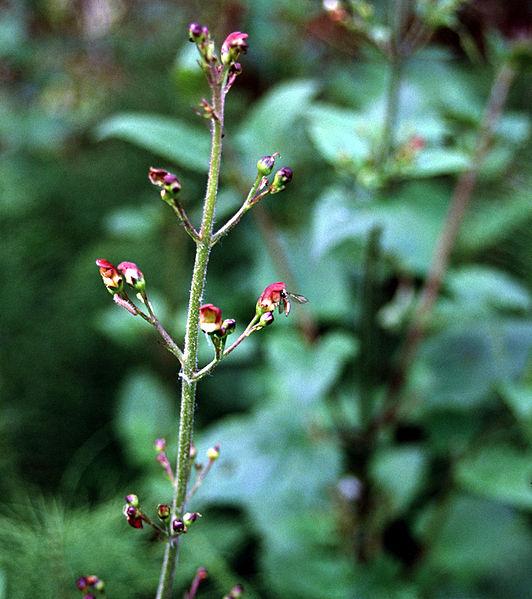
|
Trichostema lanatum
Pronunciation
try-CO-stem-uh la-NAY-tum
Common Name
Woolly Blue Curls
Plant Type
Shrub
Mature Size
3-4 ft. high & wide
Water Requirements
None: avoid summer water
Sun/Shade Requirements
Full sun
Wildlife
Flower Color
Violet to blue
Where to See
Maintenance- Design- Planting Tips
PADG Notes: We approached growing the California native Woolly Blue Curls with some trepidation because it has a reputation for being difficult. It is sensitive to over watering and poor draining soil and often is short lived. But it has beautiful flowers and foliage that smells like bubble gum when rubbed.
Several years ago, a Woolly Blue Curls plant was added to our California native plant bed. The plant was mulched with rock to improve drainage and received no additional summer water. It has bloomed and grown over the years, but it really wants a sunnier spot. The plant is reaching out for more light and has woody, unattractive stems. We’ve avoided cutting the plant back hard, because we have read it does not get new growth on old wood. Some sources suggest planting Woolly Blue Curls as an annual. In all honesty, if your heart is not set on a California native, there are probably easier low water plants with lavender flowers. Lavender and Mexican sage are two lavender flowered plants we think are safer choices for the novice gardener. |







